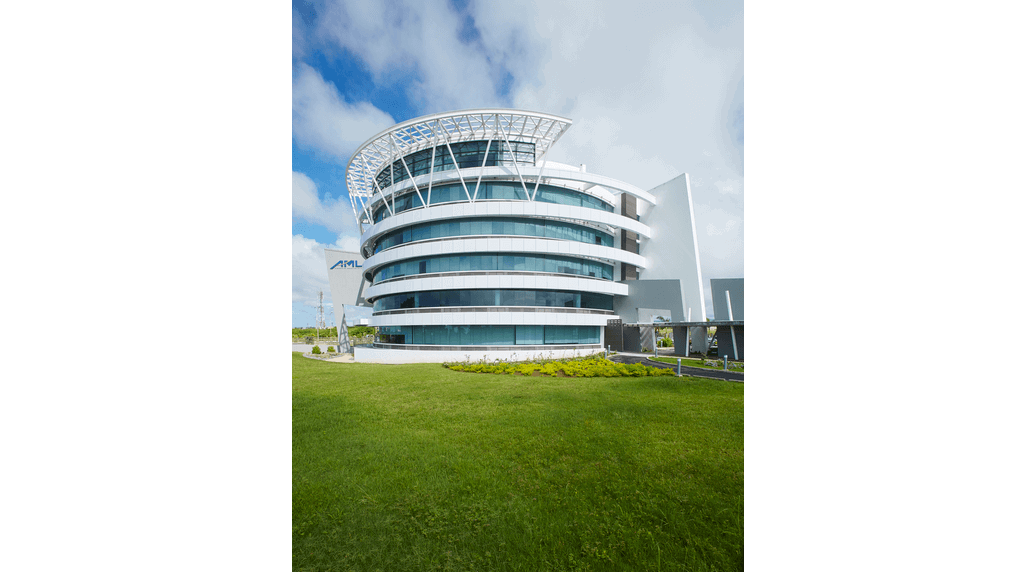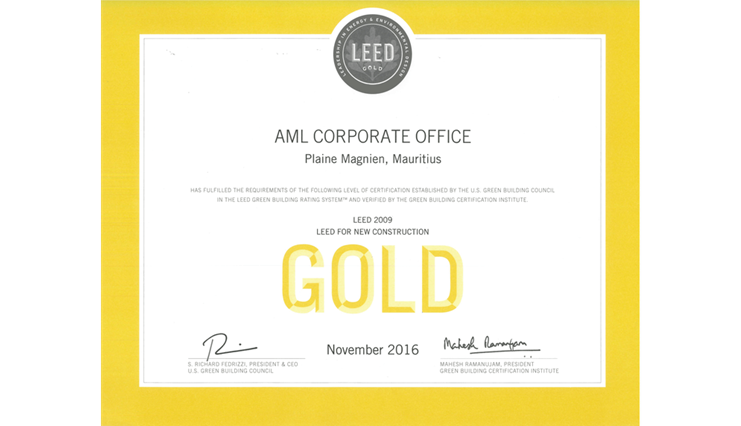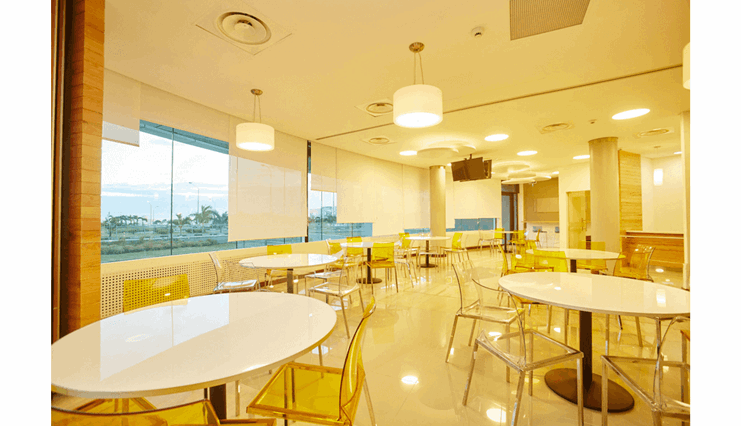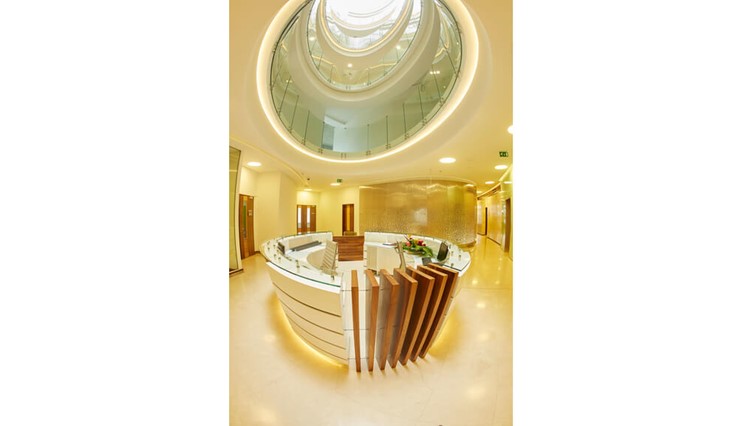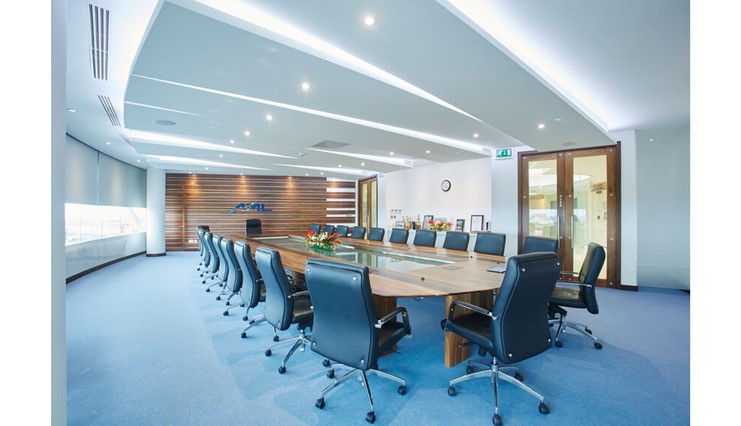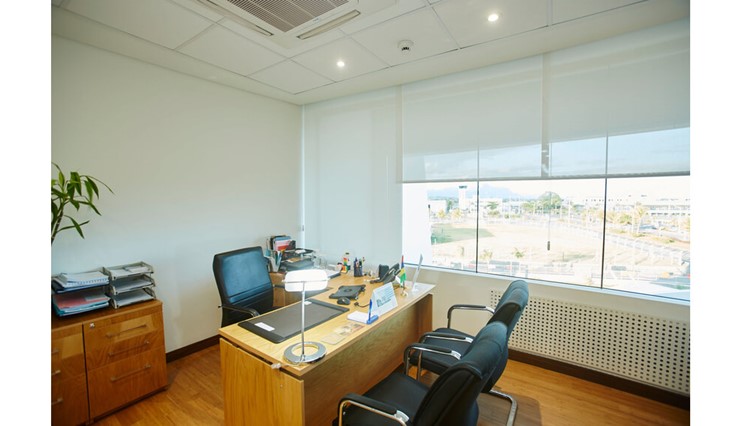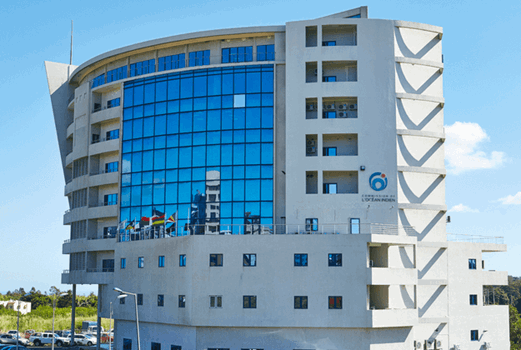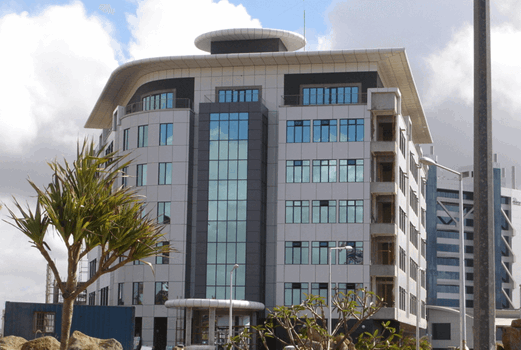For this project, we were able to take our lead from the holistic approach advocated by the USGBC. We designed the building around the LEED framework to optimise energy use and reduce waste, using recycled materials in the construction, reducing water usage through recycling, and harnessing daylight and natural ventilation. After initial hesitation – after all, the processes involved in achieving even basic LEED-certification are far from simple – AML agreed to go for a LEED qualification. Prodesign performed advanced energy modelling to achieve 18% energy savings on the ASHRAE 90.1 benchmark – which is remarkable in a tropical climate. We also were responsible for the documentation process with USGBC.
SUSTAINABLE SITE
Site selection
The designated site for constructing Airports of Mauritius’ new corporate offices is within the airport area and neither encroaches on prime farmland nor an area earmarked for agriculture. It does not provide any habitat for endangered species nor is the land prone to flooding. In fact, the positioning of the building on the site was determined after a proper risk assessment of this aspect.
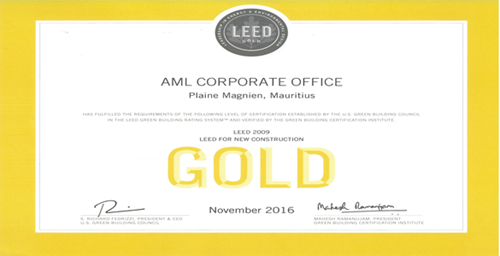
Alternative transportation
The AML Corporate Office aims to contribute towards a change in the transportation system to the site by including the following fundamental design features:
Public Transport
The project site is within 400 metres of a bus stop, thus giving building users easy access to public transportation and thereby encouraging them to leave their cars at home.
Encouraging use of fuel efficient or electric vehicles
Preferred parking spaces near the entrance of the building have been reserved for fuel-efficient and low-emission vehicles, for which 9% of parking spaces have been earmarked, with a further 15.6% of parking spaces for those participating in car and van sharing.
Encouraging cycling within the airport complex
Bicycle racks for the equivalent of 5% of full-time building occupants have been included in the project to provide secure locking for bicycles.
Erosion and sedimentation control
As a mandatory component of the LEED green building rating framework, the project devised a comprehensive erosion and sedimentation control plan, which was rigorously applied during construction works to protect neighbouring water channels and road drains, as well as prevent air pollution by dust and particulate matter during windy periods.
Around 60% of the project site consists of open spaces which have been fully planted, contributing to the biodiversity of the project as well as providing permeable areas to allow rainwater run-off, which can percolate through and replenish the underground aquifer system. Exceeding the minimum requirement for 20% open space, the project was awarded an exemplary performance point under the Innovation in Design category.
Minimising heat island effect
The heat island effect, caused by heat amassed by hard surfaces, has been reduced by covering some of the parking spaces using roof finishes with a solar reflective index (SRI) above 88. Tall trees have been planted to shade part of the external paved surfaces from solar radiation, which also helps in reducing the heat island effect.
Water Efficiency
Reducing water consumption
Water efficiency is a regional priority credit in view of the scarcity of this resource throughout the year. This was recognised and addressed right from the start of the project, when Prodesign advised the Architect on the types of fixtures to be specified and installed. This resulted in achieving a 42% reduction compared with what is required for a LEED baseline building.
Irrigation and landscape design
Water savings have also been produced by using reclaimed water from the central sewer treatment plant for irrigation purposes, thus reducing overall demand on mains water. The water required for irrigation has been reduced by 68.87% by choosing plant species with a low watering requirement, albeit needing a higher water level during the establishment period, as allowed by LEED. Once established, the plants selected for landscaping will have an irrigation requirement that can be totally covered by the reclaimed water obtained from the central sewer treatment plan.
Waste-water recycling
The waste water generated from the project building is treated by the central sewer treatment plant, thereby supporting the principle of managing as much waste generated from the building operation as possible in an environmentally-friendly way.
USBGC recognition of the water-efficiency efforts
The USGBC has recognised the special effort made by the project in reducing the mains and irrigation water demand, awarding three credits under this category. The first was achieved based on reginal priority, the second on achieving a more than 40% reduction in water use as compared to a baseline building, and the third by ensuring that only recycled water is used for irrigation.
Energy and atmosphere
Optimised energy use
The building’s energy performance has been optimised by using advanced building energy modelling and dynamic simulation tools from the outset of the project, so that elements of the building architecture and building services could be optimised during the conceptual and detailed design phase. These elements were set to reduce solar heat gain into the building, with due consideration given to harnessing daylight and promoting natural ventilation. Dynamic daylight simulations and computational fluid dynamics for assessing wind-pressure gradients around the building were carried out in order to study the potential for daylighting the building and using natural ventilation during certain periods of the year. This hybrid design approach, making use of passive and active systems, helped the building achieve high levels of energy performance.
An independent commissioning agent (CxA) was appointed to oversee the whole commissioning process as well as ensuring that the building had met AML’s requirements.
Quality of the indoor environment
Increased ventilation and IAQ performance
The building ventilation systems are managed centrally by an automatic control system, which helps to monitor the performance of outdoor air delivery systems. A CO2 concentration measurement system was designed to guard against high levels of carbon dioxide in office spaces with high occupant density. The level of CO2 is used to regulate the operation of the demand-control ventilation system, thereby enhancing the system’s energy performance by operating fans only when natural ventilation schemes are ineffective in flushing away the CO2 produced by occupants as a result of an adverse low pressure gradient across the building. This is an example of a hybrid passive/active mode of control of building systems.
Finally, occupancy of the building was authorised only after the successful testing for key IAQ parameters such as formaldehyde, 4-phenylcyclohexane (4-PCH), carbon monoxide (CO), particulate (PM10) and total volatile organic compound (TVOCs) levels.
Low-emitting materials
The use of low-emitting materials was made a requirement in order to significantly reduce the concentration of contaminants, once the building was occupied, emanating from such substances as adhesives and sealants, paints and coatings, and flooring systems (low VOC content specified). This was to ensure that the health of occupants is not negatively affected by inadequate indoor air quality. Together with the indoor air quality management plan devised during the construction phase, as described above, it has been possible to ensure that an acceptable level of indoor air quality can be obtained with minimal additional effort.
Property highlights
Natural ventilation system
A natural ventilation system was installed, consisting of louvres located at low level on the building façade, with a motorised damper on each grille, to control the fresh air entering the office. This is interfaced with a control system using carbon dioxide sensors, to monitor the internal air quality inside the office with respect to outdoor conditions, and is integrated with the mechanical cooling system. There is a local control in each office space to regulate the motorised damper. It also has an inbuilt thermostat which feeds the room temperature information to the fan-coil unit. In winter and during some of the transition months, natural ventilation is used to cool the offices. An occupant is able to control airflow entering a room by manually opening or closing the dampers. In auto mode, the opening and closing of the damper is controlled by the carbon dioxide sensors and the room thermostat.
Should an occupant wish to further reduce the temperature, he can reduce the thermostat setting and the mode changes to active cooling. The a/c unit kick starts and the motorised damper in the natural ventilation louvres moves to a 10% opening aperture, to allow only fresh air in. This opening position is then controlled by the carbon monoxide sensors, by further opening the dampers when the CO2 level rises, and vice versa.
There is a time-controlled shutdown of a/c units, which ensures that they are switched off after 5 p.m. and during week-ends, when the office is closed. A presence detector has also been provided in offices to switch off mechanical cooling when no user is within a room space or to override the timer control in case an office is occupied beyond normal working hours.
Harnessing natural lighting
The building has a central atrium to provide the core of the building with natural light, while promoting a stack effect, encouraging natural ventilation in corridors and throughout the offices, where air enters from perimeter louvres and exits through the atrium.
Office spaces are oriented to allow maximum penetration of daylight, which is aimed at reducing the use of artificial lighting in perimeter spaces during the day. To achieve the desired light level, the lighting control system ensures that rows of light near the façade are off while those in deeper parts of the office are on.
The glazed façade provides most occupants access to external views which, in addition to good air quality and adequate light levels, promotes productivity and a sense of well-being. Based on calculations carried out in line with LEED requirements, more than 75% of regularly occupied space in the building can be daylit and most of the regularly occupied spaces have access to external views.
Good indoor air quality
To promote good air quality, the building is designed with systems at the main entrance points to trap dirt and prevent the carrying of contaminants into the interior. In line with Mauritian building regulations, smoking is not allowed in buildings. This relieves the need for high levels of extraction rates, which are detrimental to energy efficiency, in buildings in some other countries.
Enhanced acoustical performance
The AML corporate office has been constructed so that its impact on its surrounding areas is minimised, and this includes its acoustic impact on the neighbourhood. Despite this and the fact that the highway leading to the airport also influences the site acoustic environment, the project team implemented various measures to ensure that outdoor sound day-night equivalent levels (Ldn) or community noise equivalent levels (CNEL) do not exceed 60dBA at the project boundary.
As part of the design process, Prodesign identified all the noise-generating equipment and ensured that the design, location and selection help to reduce the impact of noise from the building and/or site and mitigate any nuisance factors. Features such as low-noise fans, acoustic baffles, silencers and anti-vibration supports were all examined and implemented during the design process.
Acoustical site planning/design uses the lie of a building to minimise noise impact by orienting it to shield surrounding areas from noise. The building has therefore been oriented with its glazed façade towards the main road leading to the airport compound and the rear façade is now facing an empty plot of land.
Other site planning techniques, such as distance, were employed to shield the building and any potential residential development in the surroundings from noise. These included placing non-residential land uses, such as parking areas, maintenance facilities, landscaping and utility areas, between the source and the receiver. Specifically to minimise external road noise from affecting building users, careful consideration was given to setting back the main building from the site boundary when determining its positioning.
Access to the site was also carefully addressed by the design team and the local authority to ensure that there is no adverse impact on the highway and on the main road leading to the airport. As such, the main entrance leading to the site was located so as to ensure that visitors have to reduce their speed before entering the site. A traffic barrier was provided as a means of reducing speed and for security control reasons. Site internal roadways were designed with traffic lines, road curves and bends to limit speed while simultaneously reducing noise levels.
Finally, noise level measurements and verification checks were carried out at the five measuring stations which demonstrated that the day-night sound level (Ldn) was at or below 60dB(A) at any time. The outcome was that the project was able to gain a pilot credit under USGBC innovation criteria.
During construction
A series of measures were taken during the construction phase of the project in line with LEED requirements, to protect the environment, site workers and the surrounding eco-system:
Construction activity pollution prevention
The construction phase was planned so that, as much as possible, there was minimum air, noise and water pollution as a result of construction-related activities.
Construction waste management plan
A construction waste management plan was devised to measure and track solid waste during construction, with an emphasis on diverting maximum waste from landfills to recycling companies.
Buffer zone
Zones were earmarked on the site to protect existing green areas from damage during the construction phase (no-disturbance zones), in line with LEED specific distance recommendations. The project site was designed with extensive green or planted areas, which helps provide outdoor living spaces and generally benefits the natural environment.
Indoor air-quality monitoring
An indoor air-quality management plan was devised to ensure proper housekeeping and work methods during the construction phase. This helped considerably to achieve a good level of indoor air quality before occupancy, requiring minimal further

